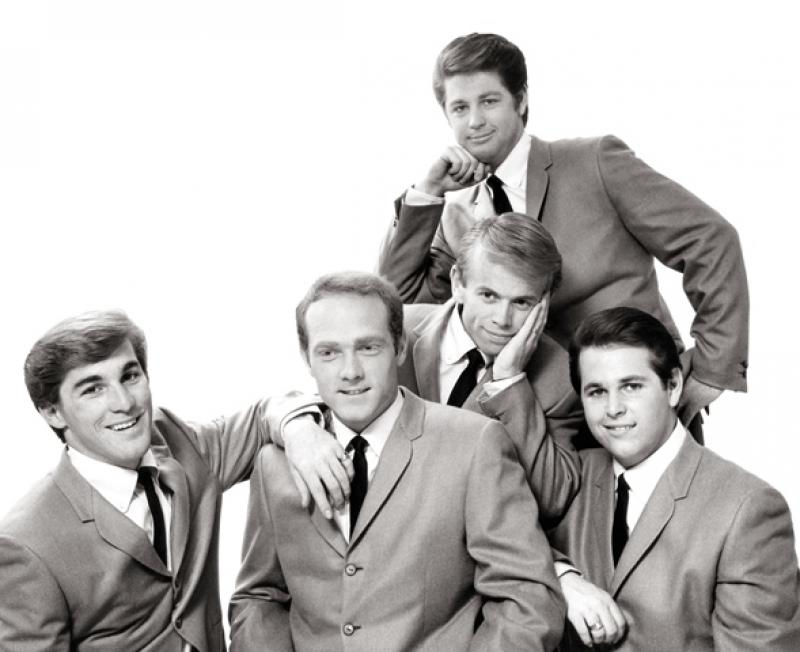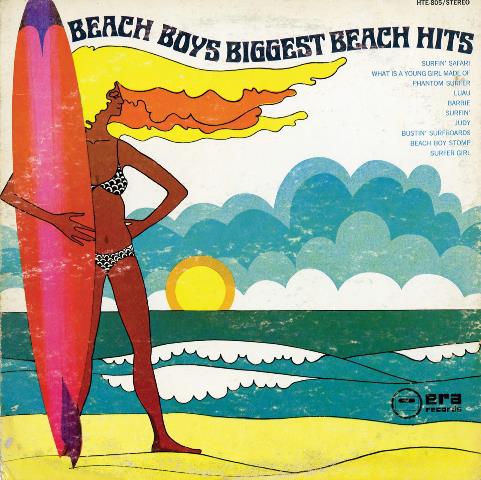Reissue CDs Weekly: The Beach Boys | reviews, news & interviews
Reissue CDs Weekly: The Beach Boys
Reissue CDs Weekly: The Beach Boys
Fan-only only package of Brian Wilson and co’s complete pre-Capitol tapes

The Beach Boys signed with Capitol Records on 24 May 1962. Early the next month, their first single for the label became “409”/”Surfin’ Safari”. It was not their debut release. The “Surfin'”/ “Luau” single had been issued in November 1961 by Candix.
Before Capitol, Hite and Dorinda Morgan had brought them into a recording studio. The former was a music publisher known by Murry Wilson, the father of Beach Boys’ Brian, Carl and Dennis. When the Morgans first encountered the band, they were known as The Pendeltones. Without being asked, they were renamed The Beach Boys for the release of "Surfin'”. Their next single, “Barbie”/“What is a Young Girl Made of” was credited to Kenny and the Cadets. For this, the Morgans had the band track their vocals over pre-recorded instrumental tracks. The identity crisis ceased once they were with Capitol.
 Becoming the Beach Boys: The Complete Hite & Dorinda Morgan Sessions collects everything from the surviving tapes recorded before the Capitol signing. Across two discs, the 62 tracks include a demo, eight takes and the master of “Surfin’”. For “Luau”, there is a demo, 18 takes and the master. Similarly in-depth sequences are devoted to “Barbie”, “Beach Boy Stomp”, "Judy", “Lavender”, “Surfer Girl”, “Surfin’ Safari” and “What is a Young Girl Made of”.
Becoming the Beach Boys: The Complete Hite & Dorinda Morgan Sessions collects everything from the surviving tapes recorded before the Capitol signing. Across two discs, the 62 tracks include a demo, eight takes and the master of “Surfin’”. For “Luau”, there is a demo, 18 takes and the master. Similarly in-depth sequences are devoted to “Barbie”, “Beach Boy Stomp”, "Judy", “Lavender”, “Surfer Girl”, “Surfin’ Safari” and “What is a Young Girl Made of”.
At the Morgan’s home in September 1961, they had recorded a demo of “Surfin’”, a demo and three takes of “Luau”, a rehearsal and a take of “Lavender”. All three songs were next taped at either World Pacific or Stereo Masters in October or November 1961. “Surfin’ Safari”, “Surfer Girl”, “Judy”, and “Beach Boy Stomp” (aka “Karate”) were then recorded at World Pacific Studio on 8 February 1962. The vocals of “Barbie” and “What is a Young Girl Made of” were taped at Stereo Masters on 8 March 1962. These sessions comprise what's heard on Becoming the Beach Boys.
The Beach Boys’ subsequent success and fame ensured that some of what had initally been unheard did not stay on the shelf. The scrappy and cheekily titled 1969 album Beach Boys Biggest Hits (pictured below left) was the first release to exploit these tapes (two of its tracks weren't by The Beach Boys). The 1991 Lost and Found (1961–1962) CD sampled the tapes more extensively and was the first time they were issued with annotation and proper packaging. The arrival of Becoming the Beach Boys with its wholesale approach renders the 1991 release (and reissues of it) redundant.
 While historically important, the aural baby pictures on Becoming the Beach Boys will be a slog for anyone who is not a full-on fan. The studio chat is fun, but successive runs through “Judy” are taxing and ultimately irritating. Even though it is an early Brian Wilson composition, hearing the trite song repeatedly is an endurance test. It's slight, written by a neophyte songwriter and the performers are a just-formed band. This is not the eternally fascinating Beach Boys of “Good Vibrations” or even “Fun Fun Fun”, but an embryonic band groping their way towards finding out who they were. When perfection is reached, the preceding repetition has rendered appreciation of the final master of "Judy" impossible.
While historically important, the aural baby pictures on Becoming the Beach Boys will be a slog for anyone who is not a full-on fan. The studio chat is fun, but successive runs through “Judy” are taxing and ultimately irritating. Even though it is an early Brian Wilson composition, hearing the trite song repeatedly is an endurance test. It's slight, written by a neophyte songwriter and the performers are a just-formed band. This is not the eternally fascinating Beach Boys of “Good Vibrations” or even “Fun Fun Fun”, but an embryonic band groping their way towards finding out who they were. When perfection is reached, the preceding repetition has rendered appreciation of the final master of "Judy" impossible.
This nascent Beach Boys were steered by their sponsors. They did what they were told to do. “Luau”, the icky “Lavender”, the doll-craze cash-in “Barbie” and “What is a Young Girl Made of” were not band compositions but by the Morgans, so are musical entries in the margins of The Beach Boys' story. Their significance lies solely in being early recordings by what would become one of the world’s best bands.
Where Becoming the Beach Boys fascinates is in tracking the band and Brian Wilson’s swift path towards finding their own voice. Disc One, Track One is a skeletal demo of “Surfin’” which suggests the band were already vocally proficient and engaging when they were on the starting block. But, unsurprisingly, it is wobbly. Disc Two begins with Take One of “Surfer Girl”. Despite the shaky vocal meshing, the band is taking shape. Smoothness and confidence are emerging. By Take Seven, the master, the track really sounds like a radio-friendly hit single in waiting. Even so, listening to Becoming the Beach Boys as if it were a traditional album is impossible. The only ears which will get something from it are those already deeply familiar with The Beach Boys’ earliest days. This is no casual purchase.
Share this article
The future of Arts Journalism
You can stop theartsdesk.com closing!
We urgently need financing to survive. Our fundraising drive has thus far raised £49,000 but we need to reach £100,000 or we will be forced to close. Please contribute here: https://gofund.me/c3f6033d
And if you can forward this information to anyone who might assist, we’d be grateful.

Subscribe to theartsdesk.com
Thank you for continuing to read our work on theartsdesk.com. For unlimited access to every article in its entirety, including our archive of more than 15,000 pieces, we're asking for £5 per month or £40 per year. We feel it's a very good deal, and hope you do too.
To take a subscription now simply click here.
And if you're looking for that extra gift for a friend or family member, why not treat them to a theartsdesk.com gift subscription?
more New music
 Album: Boz Scaggs - Detour
Smooth and soulful standards from an old pro
Album: Boz Scaggs - Detour
Smooth and soulful standards from an old pro
 Emily A. Sprague realises a Japanese dream on 'Cloud Time'
A set of live improvisations that drift in and out of real beauty
Emily A. Sprague realises a Japanese dream on 'Cloud Time'
A set of live improvisations that drift in and out of real beauty
 Trio Da Kali, Milton Court review - Mali masters make the ancient new
Three supreme musicians from Bamako in transcendent mood
Trio Da Kali, Milton Court review - Mali masters make the ancient new
Three supreme musicians from Bamako in transcendent mood
 Hollie Cook's 'Shy Girl' isn't heavyweight but has a summery reggae lilt
Tropical-tinted downtempo pop that's likeable if uneventful
Hollie Cook's 'Shy Girl' isn't heavyweight but has a summery reggae lilt
Tropical-tinted downtempo pop that's likeable if uneventful
 Pop Will Eat Itself's 'Delete Everything' is noisy but patchy
Despite unlovely production, the Eighties/Nineties unit retain rowdy ebullience
Pop Will Eat Itself's 'Delete Everything' is noisy but patchy
Despite unlovely production, the Eighties/Nineties unit retain rowdy ebullience
 Music Reissues Weekly: The Earlies - These Were The Earlies
Lancashire and Texas unite to fashion a 2004 landmark of modern psychedelia
Music Reissues Weekly: The Earlies - These Were The Earlies
Lancashire and Texas unite to fashion a 2004 landmark of modern psychedelia
 Odd times and clunking lines in 'The Life of a Showgirl' for Taylor Swift
A record this weird should be more interesting, surely
Odd times and clunking lines in 'The Life of a Showgirl' for Taylor Swift
A record this weird should be more interesting, surely
 Waylon Jennings' 'Songbird' raises this country great from the grave
The first of a trove of posthumous recordings from the 1970s and early 1980s
Waylon Jennings' 'Songbird' raises this country great from the grave
The first of a trove of posthumous recordings from the 1970s and early 1980s
 Lady Gaga, The Mayhem Ball, O2 review - epic, eye-boggling and full of spirit
One of the year's most anticipated tours lives up to the hype
Lady Gaga, The Mayhem Ball, O2 review - epic, eye-boggling and full of spirit
One of the year's most anticipated tours lives up to the hype
 Slovenian avant-folk outfit Širom’s 'In the Wind of Night, Hard-Fallen Incantations Whisper' opens the door to inner space
Unconventional folk-based music which sounds like nothing else
Slovenian avant-folk outfit Širom’s 'In the Wind of Night, Hard-Fallen Incantations Whisper' opens the door to inner space
Unconventional folk-based music which sounds like nothing else
 'The Art of Loving': Olivia Dean's vulnerable and intimate second album
Neo soul Londoner's new release outgrows her debut
'The Art of Loving': Olivia Dean's vulnerable and intimate second album
Neo soul Londoner's new release outgrows her debut

Add comment